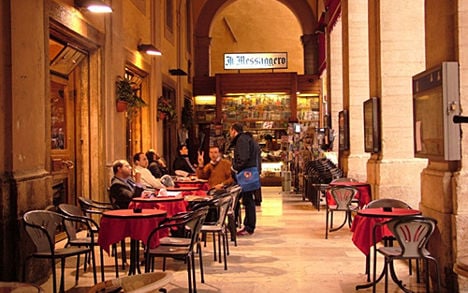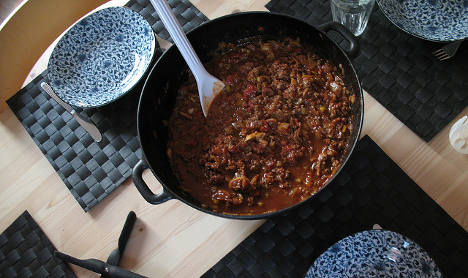Why you won't find spaghetti bolognese in Italy

It's the world's favourite Italian dish - except it doesn't actually exist. Food blogger and culinary tour operator Monica Cesarato explains the history and myth of spaghetti bolognese.
It's a scene I have experienced over and over in Venice and I am sure the same thing plays out across Italy on a daily basis.
After months of dreaming of the sun, the sandy beaches and an enormous plate of pasta covered with Bolognese sauce and freshly grated Parmesan, a tourist finally finds themselves sitting at a restaurant in Italy.
But after nervously checking the menu, their expression changes. Spaghetti alla Bolognese is nowhere to be seen.
“What do you mean there's no Bolognese?!” The tourist asks the startled waiter, who politely suggests in broken English that they try the tagliatelle al ragù instead.
 Photo:Mark Goebel/Flickr
Photo:Mark Goebel/Flickr
READ MORE: Ten 'Italian' dishes that don't exist outside Italy
Bolognese is a dish that seems to create confusion outside Italy.
Recently the famous dish was the subject of a heated online controversy, sparked by the New York Times publishing a recipe for a 'white' Bolognese sauce, with no tomatoes. The recipe had many Italians, especially those from Bologna, on the warpath.
They were quick to defend the 'right' way of preparing Ragù alla Bolognese - with tomatoes as one of the main ingredients.
But instead of drawing our virtual swords, perhaps we should take a deep breath and we clear the air about Bolognese. (And by the way, that's Bolognese, not 'Bolognaise', as I have seen it spelled around the world.)
First of all, Ragù alla Bolognese, or Bolognese sauce, is only one of the many ways which a meat sauce – or Ragù - can be prepared in Italy.
Ragù in Italy is a general term, used to indicate any meat sauce cooked over low heat for many hours. Each ragù is composed of numerous ingredients, which vary according to each region – hence “alla Bolognese”, meaning from the town of Bologna.
READ MORE: How to decipher Italy's mind-boggling pasta menus

Photo: Sharon Mollerus/Flickr
Here in Italy at least, the Bolognese version of Ragù contains tomatoes and is only served with tagliatelle, tortellini or gnocchi, and never with spaghetti – unless you are eating in a restaurant only for tourists. These thicker pastas are more able to hold the chunky sauce.
Let’s take a look at the dish's history.
According to Livio Cerini, one of the greatest Italian cookbook writers of the twentieth century, we have the Romans to thank for this appetizing style of preparing meaty sauces.
But the term Ragù originates from the French word ragôuter, a verb which can be translated into something like "to add flavour to something". This is because during the period of the Roman invasion, the Gauls reworked the Roman recipe, transforming it into the ragout, much similar to the sauces we know today.
Initially, ragù sauces were a kind of stew eaten as a main course, but they then started being eaten spread atop toasted bread.
Of course, all of these early ragù dishes were made without tomatoes, since tomatoes didn't arrive in Europe from the New World until the 1500s, thanks to Hernan Cortes and the Conquistadores.
It is thought that the birth of the original recipe for Ragu alla Bolognese can be traced back to the end of the 1700s. It was then that Alberto Alvisi, the chef of the Cardial of Imola, cooked the first real tomato-based meat sauce, which was served with a plate of macaroni pasta.
By the beginning of the 1800s, recipes for tomato-based ragù start to appear in some cookbooks from the Emilia-Romagna region. However, at this time it was a dish that, was generally reserved for holidays or special occasions.
 Photo:Lisa Risager/Flickr
Photo:Lisa Risager/Flickr
The original recipe for Bolognese sauce was shaped over the intervening years and the 'official' version of the recipe was registered by the Italian Academy of Cuisine at the Bologna Chamber of Commerce on October 17th 1982.
In the official version, bacon and milk are listed among the usual ingredients. Milk! Surprising, isn't it?
But whether or you put milk in your Bolognese or not, one main thing remains. Without tomatoes, we would refer the these sauces simply as ragù. Hence the outrage of the many Italians against a 'white' Bolognese.
In Italy, perhaps only when it comes to food are we very technical and precise!
Nowadays, in Italy, Ragu sauces aren't just made with meat: they can also be prepared with fish (sea bass and sea bream are popular choices), vegetables and even tofu.
But how many types of meat ragù sauce are out there? Countless versions! Some people prepare it with only one type of meat, some use garlic, others use rosemary, and some use venison. wild boar and even lamb to make their sauce.
Apart from Bolognese, the most famous version of a tomato-based ragù is perhaps from Naples.
Neapolitan ragù, is made with tomatoes and whole pieces of meat, cut as if they were pieces of a stew. The meat comes from different animals: beef, veal and pork. The whole thing is simmered for several hours, until it becomes soft and tasty.
Worth trying sometime – especially if Bolognese isn't on the menu.
Buon appetito.
Monica Cesarato is a food blogger, culinary tour guide and teaches cookery courses in Venice. She is currently co-writing a book with about Cicchetti (Venice version of tapas). To find out more about her food tours and cookery classes go to her Cook in Venice website.
Comments
See Also
It's a scene I have experienced over and over in Venice and I am sure the same thing plays out across Italy on a daily basis.
After months of dreaming of the sun, the sandy beaches and an enormous plate of pasta covered with Bolognese sauce and freshly grated Parmesan, a tourist finally finds themselves sitting at a restaurant in Italy.
But after nervously checking the menu, their expression changes. Spaghetti alla Bolognese is nowhere to be seen.
“What do you mean there's no Bolognese?!” The tourist asks the startled waiter, who politely suggests in broken English that they try the tagliatelle al ragù instead.
 Photo:Mark Goebel/Flickr
Photo:Mark Goebel/Flickr
READ MORE: Ten 'Italian' dishes that don't exist outside Italy
Bolognese is a dish that seems to create confusion outside Italy.
Recently the famous dish was the subject of a heated online controversy, sparked by the New York Times publishing a recipe for a 'white' Bolognese sauce, with no tomatoes. The recipe had many Italians, especially those from Bologna, on the warpath.
They were quick to defend the 'right' way of preparing Ragù alla Bolognese - with tomatoes as one of the main ingredients.
But instead of drawing our virtual swords, perhaps we should take a deep breath and we clear the air about Bolognese. (And by the way, that's Bolognese, not 'Bolognaise', as I have seen it spelled around the world.)
First of all, Ragù alla Bolognese, or Bolognese sauce, is only one of the many ways which a meat sauce – or Ragù - can be prepared in Italy.
Ragù in Italy is a general term, used to indicate any meat sauce cooked over low heat for many hours. Each ragù is composed of numerous ingredients, which vary according to each region – hence “alla Bolognese”, meaning from the town of Bologna.
READ MORE: How to decipher Italy's mind-boggling pasta menus

Photo: Sharon Mollerus/Flickr
Here in Italy at least, the Bolognese version of Ragù contains tomatoes and is only served with tagliatelle, tortellini or gnocchi, and never with spaghetti – unless you are eating in a restaurant only for tourists. These thicker pastas are more able to hold the chunky sauce.
Let’s take a look at the dish's history.
According to Livio Cerini, one of the greatest Italian cookbook writers of the twentieth century, we have the Romans to thank for this appetizing style of preparing meaty sauces.
But the term Ragù originates from the French word ragôuter, a verb which can be translated into something like "to add flavour to something". This is because during the period of the Roman invasion, the Gauls reworked the Roman recipe, transforming it into the ragout, much similar to the sauces we know today.
Initially, ragù sauces were a kind of stew eaten as a main course, but they then started being eaten spread atop toasted bread.
Of course, all of these early ragù dishes were made without tomatoes, since tomatoes didn't arrive in Europe from the New World until the 1500s, thanks to Hernan Cortes and the Conquistadores.
It is thought that the birth of the original recipe for Ragu alla Bolognese can be traced back to the end of the 1700s. It was then that Alberto Alvisi, the chef of the Cardial of Imola, cooked the first real tomato-based meat sauce, which was served with a plate of macaroni pasta.
By the beginning of the 1800s, recipes for tomato-based ragù start to appear in some cookbooks from the Emilia-Romagna region. However, at this time it was a dish that, was generally reserved for holidays or special occasions.
 Photo:Lisa Risager/Flickr
Photo:Lisa Risager/Flickr
The original recipe for Bolognese sauce was shaped over the intervening years and the 'official' version of the recipe was registered by the Italian Academy of Cuisine at the Bologna Chamber of Commerce on October 17th 1982.
In the official version, bacon and milk are listed among the usual ingredients. Milk! Surprising, isn't it?
But whether or you put milk in your Bolognese or not, one main thing remains. Without tomatoes, we would refer the these sauces simply as ragù. Hence the outrage of the many Italians against a 'white' Bolognese.
In Italy, perhaps only when it comes to food are we very technical and precise!
Nowadays, in Italy, Ragu sauces aren't just made with meat: they can also be prepared with fish (sea bass and sea bream are popular choices), vegetables and even tofu.
But how many types of meat ragù sauce are out there? Countless versions! Some people prepare it with only one type of meat, some use garlic, others use rosemary, and some use venison. wild boar and even lamb to make their sauce.
Apart from Bolognese, the most famous version of a tomato-based ragù is perhaps from Naples.
Neapolitan ragù, is made with tomatoes and whole pieces of meat, cut as if they were pieces of a stew. The meat comes from different animals: beef, veal and pork. The whole thing is simmered for several hours, until it becomes soft and tasty.
Worth trying sometime – especially if Bolognese isn't on the menu.
Buon appetito.
Monica Cesarato is a food blogger, culinary tour guide and teaches cookery courses in Venice. She is currently co-writing a book with about Cicchetti (Venice version of tapas). To find out more about her food tours and cookery classes go to her Cook in Venice website.
Join the conversation in our comments section below. Share your own views and experience and if you have a question or suggestion for our journalists then email us at [email protected].
Please keep comments civil, constructive and on topic – and make sure to read our terms of use before getting involved.
Please log in here to leave a comment.